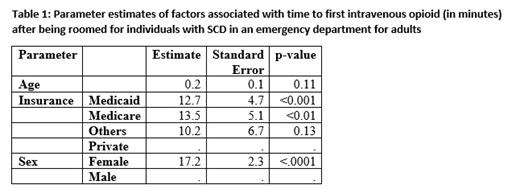Background: Individuals with sickle cell disease (SCD) often require emergent care to manage debilitating pain. The American Society of Hematology recommends individuals seeking care for the treatment of acute pain should have their pain assessed and medication administered within one hour of their arrival at the emergency department (ED). Data regarding guideline timeliness of pain treatment in adults are not well understood. We therefore sought to determine the timeliness of care for pain treatment in the ED for adults with SCD and factors associated with timeliness of care. We hypothesized that those using public insurance will have greater delays in receipt of intravenous opioids for pain.
Methods: We leveraged the Center for Disease Control's Sickle Cell Data Collection Program in Wisconsin to identify individuals with SCD who received care in the ED associated with the adult SCD comprehensive clinic between 2017-2020. Individuals were identified as having SCD if confirmed via the state newborn screening program or if they had 3 or more visits/claims with a diagnosis of SCD in a five-year time frame. ED treat and release visits with 1) any diagnosis of pain or vaso-occlusive crises, and 2) receipt of an intravenous opioid were considered painful crises. The timeliness of ED pain treatment was determined by calculating the time between placement in an ED room and receipt of first intravenous opioid. All analyses were conducted at the visit level. A multivariable generalized linear model was used to determine if age, sex or insurance status were associated with time to opioid administration.
Results: There were 382 individuals with SCD who contributed to 3400 ED treat and release visits; 1755 were for painful crises. The mean age of individuals was 31.8 (SD = 9.5) years and the majority of the visits were by females (64%). The primary payers included Medicaid (63.9%), Medicare (25.6%), private (5.7%), and other (4.7%). The median time to administration of intravenous opioids after being roomed was 57 minutes (IQR: 39 - 86 minutes). Intravenous opioids were not administered within 60 minutes of being roomed for 43% of the ED visits. The multivariable model demonstrated that females (as compared to males; 72.6 vs 55.4 minutes), and those on Medicaid and Medicare (70.4 and 72.6 minutes respectively as compared to private insurance 46 minutes) had a significantly longer time to receipt of first intravenous opioid (Table 1).
Conclusion: Our data show that intravenous opioids were not given within 60 minutes of being roomed for more than 40% of ED visits for pain at an adult care facility . These analyses do not include the time in waiting room prior to being roomed, thus the problem of timely care is worse than reflected by these results. Females and those on public insurance have significantly longer time to receipt of pain treatment. Immediate work is needed to identify steps to ensure that adults with SCD seeking emergent care for pain receive guideline-adherent pain treatment.
Disclosures
Brousseau:CSL Behring: Consultancy, Honoraria.


